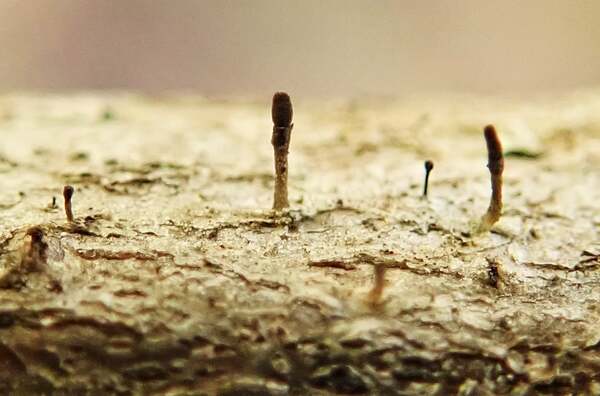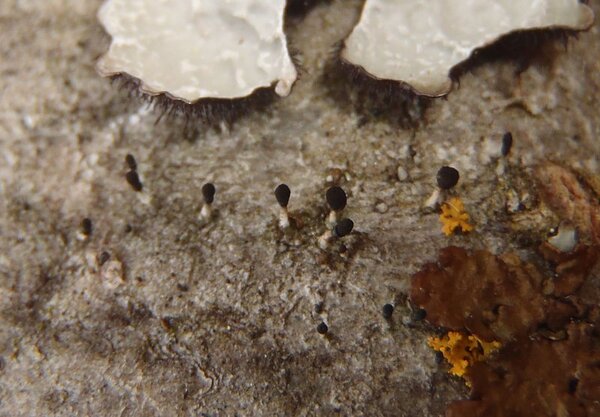Allocalicium adaequatum (Nyl.) M. Prieto & Wedin
Fungal Diversity, 82: 234, 2016. Basionym: Calicium adaequatum Nyl. - Flora, 52: 409, 1869
Synonyms: Calicium marianum (Nádv.) Nádv.
Distribution:
Description: Thallus crustose, endosubstratic, poorly evident. Apothecia long-stalked, epruinose, with a dark capitulum and a pale olive-brown to pale grey stalk. Stalk 0.6-0.8 mm high, 0.007-0.009 mm thick, the outer part 5-10 µm thick, of periclinally arranged, brown hyphae, the inner part of intertwined but more or less periclinally arranged, thick-walled hyphae, I+ deep blue. Capitulum cylindrical to bell-shaped, 0.1-0.2 mm across. Exciple 20-35 µm thick, thickened in upper part, the outer part of isodiametric, brown cells, the inner part of intertwined hyphae with thick walls, I+ dark blue; hypothecium medium brown, up to 40 µm high. Asci cylindrical, formed singly, dissolving early, with uniseriately, rarely biseriately arranged spores. Ascospores 1-septate, dark brown, 9-11 x 4.5-5.5 µm, with an ornamentation of spirally arranged ridges. Photobiont chlorococcoid. Spot tests: thallus K-, C-, KC-, P-; stalk and exciple I+ dark blue. Chemistry: without lichen substances.Note: on bark (mostly on twigs) of deciduous trees (Alnus, Acer) under suboceanic conditions; rare, or only seldom collected, as it can be easily overlooked, with scattered records in the Alps outside the Italian territory; to be looked for in the Italian Alps.
Growth form: Crustose
Substrata: bark
Photobiont: green algae other than Trentepohlia
Reproductive strategy: mainly sexual

Predictive model
Growth form: Crustose
Substrata: bark
Photobiont: green algae other than Trentepohlia
Reproductive strategy: mainly sexual

Predictive model
 INDEX FUNGORUM
INDEX FUNGORUM
 GBIF
GBIF






